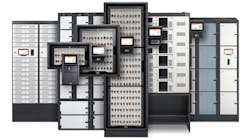In more than 20 years of covering the data center industry, I’ve seen all sorts of responses to the creation of new data centers. Both positive and negative, responses from local communities often are dependent on where the data centers are to be built, value-adds being presented to the community, and potential environmental impact.
On the other hand, political responses are often focused around the money involved, in both taxes and contributions from developers to the local communities. And, of course, there is an underlying current of the overall cost of data centers to a community when issues like rebated taxes on property are being dangled by politicians to lure data center development.
It is rare, however, to see concerted efforts to prevent the construction of data centers overall; it is almost always presented as a NIMBY case. Put your data center elsewhere. And for a number of reasons, that location concern is driving a lot of data center construction, though since the AI revolution, the availability of local resources, primarily power, has been a number one criteria for data center location selection.
Taking It to the Streets
The first report we will take a look at is the Data Center Neighborhood Survey Report, an Airedale by Modine survey. This survey report, based on data collected from 600 responses on March 7 to March 8, 2025 apparently drew from an audience that understands what a data center is and the impact of data centers on business and the economy. The key findings of the report were identified as follows:
- 70% of Americans are comfortable with a data center within just a few miles of their home.
- Many expect data centers to have a positive impact on their community in the next decade.
- 55% support tax incentives to encourage data center development.
- Noise pollution and energy consumption lead the list of concerns about data centers.
- 62% said data center owners contributing to local initiatives would improve their perceptions of data centers.
- 59% believe data centers are essential for maintaining the U.S.’s global competitiveness in technology and innovation.
Airedale summarized their results as, “When it comes to new data centers, most Americans say ‘Welcome to the neighborhood.’” Their interpretation of the result of their poll was that their wasn’t significant “NIMBY” objection to the building of data centers in, or near, residential areas.
Kimberly Raduenz, Marketing Manager – North American Data Centers, at Airedale, described the results as such:
“This survey makes one thing clear: the public is open to data center expansion, and the time to build is now. Unlike other large infrastructure projects that often face resistance, data centers are largely seen as necessary and beneficial. With nearly half of respondents expressing no opposition to having one built near their home – and many recognizing their role in keeping the U.S. at the forefront of global innovation – the industry has a unique opportunity to scale responsibly. The demand for data storage and processing isn’t slowing down, and as we build for the future, it’s critical that we do so with an emphasis on sustainability and efficiency. Smart thermal management solutions will play a key role in making this expansion both viable and environmentally responsible.”
As the industry has known for decades, business that have a demonstrable focus of minimizing environmental impact, sustainability, and being good neighbors are the ones most likely to get the goodwill from residents that can smooth the path towards new development. This is one olf the reasons that the data center industry, as a whole, needs a much more proactive approach on addressing community issues in the development process.
Being able to demonstrate just not good will, but actual community benefit from the local development of a data center is more than just a “feel good” message. It has a be a tangible goal of large-scale data center projects.
Just Say 'No'
With a report that focuses on the rise in local opposition to data center projects, Data Center Watch presents the contrary view. With a much longer research timeline, from March 2024 through May 2025, and a focus on tracking opposition to large scale data center projects, Data Center Watch has been able to document over $64 billion worth of data center projects that have been blocked or delayed in that one-year timeframe by local project opposition.
Of that, the report indicates that $18 billion worth of projects have been outright blocked, while the remainder were delayed for at least two years. According to the report, the information used to create the content was sourced by “reviewing public sources such as local media, government filings, petitions, social media, and official statements.” And unlike the neighborhood survey, looked for actual results to back up its conclusions.
On one hand, some of the conclusions on the importance of community involvement and sustainability reached by both reports showed similar areas of concern, as wll as indicating that then there are issues, the concern is bipartisan. While Democrats may focus on environmental aspects of new construction and Republicans focus on the cost of rebates and tax law changes to encourage construction, their goals remain similar; to prevent the construction of new facilities.
On the topic of NIMBY issues, the Data Center Watch report reached the opposite conclusion from the Neighbor survey. To quote directly from their summary:
“Where communities once rallied against factories, warehouses, or retail sprawl, they’re now opposing data centers. From noise and water usage to power demands and property values, server farms have become a new target in the broader backlash against large-scale development. The landscape of local resistance is shifting — and data centers are squarely in the crosshairs.”
The report concludes that data centers are the new NIMBY flashpoint, beyond the community response once reserved for a new Amazon warehouse or projects that shook up the local transportation infrastructure.
The report also points out that are no fewer than 142 grassroots organizations driving the data center project opposition in the 28 states that the report focused on. While the report does mention that some of those organizations are local chapters of national organizations such as the Sierra Club, it is very clear in identifying the fact that it is a grassroots effort against specific projects that are having this impact on the data center industry.
And there are a lot of local organizations fighting against the construction of data centers. For example, the Data Center Reform Coalition is an organization with no less than 41 member groups, all focused on fighting or moderating data center development in Northern Virginia. Given the number of data center projects in the region, the number of local groups is unsurprising, and those groups, joining forces to share expertise and experience in fighting big developers in building data centers, are likely to see more success in the future.
What Does the Future Hold?
The Dat Center Watch report draws the conclusion that, “As data center development accelerates elsewhere in the country, local pushback on data centers is likely to follow the same pattern seen in Virginia.” However, this conclusion would seem to only apply to regions as densely populated as Northern Virginia.
As we look at projects cropping up in much more rural areas, factors such as the short-term construction jobs; large, ongoing contributions to local communities for education and community projects, and cash guarantees of community benefits are going to offset concerns that might drive opposition in more densely populated areas.
As local acceptance of large data center projects has more of an impact on the viability of those projects, we might see the epicenters of data center construction migrate over the next few years.
The Challenge Ahead: Winning Hearts, Powering Progress
What we’re seeing isn’t a paradox; it’s more simply the reality of 2025 data center development. The same project that might be welcomed in one ZIP code can trigger backlash in another. These dueling narratives make it clear that community perception is no longer a secondary consideration, but has become an essential line item in the development plan.
For developers, this means the calculus has changed. The business case must go beyond megawatts and latency zones. It must address questions of water, noise, tax equity, and local benefit. And not just in the site plan, but in the first conversation with the community. Education helps, but evidence of mutual gain is what ultimately opens doors.
And for the industry? It’s a moment to lead with transparency and consistency. The data cente isn’t just a back-end asset anymore. It’s rapidly becoming a front-facing presence in communities across the country. To earn trust, providers need to act like it. Smart development will still find room to grow, but those who ignore public perception risk watching their billion-dollar plans stall at the city council table.
Data centers power the future. But if the future wants them nearby, they’ll need to prove they belong.
About the Author



